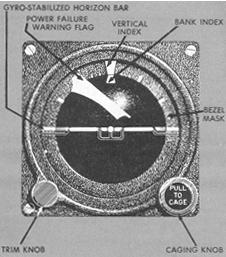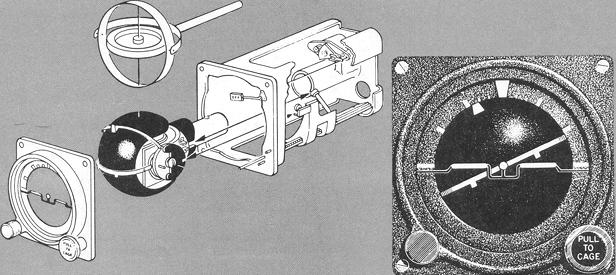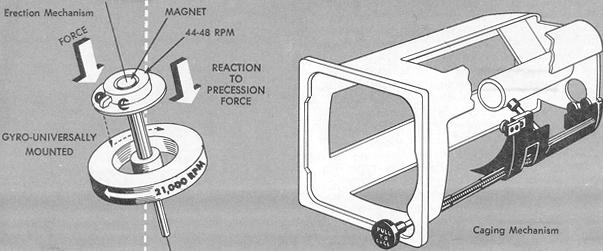| J-8 Attitude Indicator.
The J-8 has a vertical seeking gyro, the axis of rotation tending to point toward the center of the earth (Fig. 4-25). The gyro is linked with a horizon bar and stabilizes a kidney-shaped sphere with pitch attitude markings. The sphere, horizon bar, and bank index pointer move with changes of aircraft attitude. Combined readings of these presentations give a continuous pictorial presentation of the aircraft attitude in pitch and roll with respect to the earth's surface. The gyroscope motor is driven by 115-volt, 400 cycle alternating current. The gyro, turning at 21,000 rpm, is supported by the yoke and pivot assembly (gimbals). Attached to the yoke and pivot assembly is the horizon bar, which moves up and down through an arc of approximately 27°. The kidney-shaped sphere provides a background for the horizon bar and has the words CLIMB and DIVE and a bullseye painted on it. CLIMB and DIVE represent about 60° of pitch. Attached to the yoke and pivot assembly is the bank index pointer which is free to rotate 360°. The dial face of the attitude indicator is marked with 0°, 10°, 20°, 30°, 60°, and 90° of bank, and is used with the bank index pointer to indicate the degree of bank left or right. Figure 4-24. H-6b gyro horizon.
Erection and Caging Mechanisms. The function of the erection mechanism is to keep the gyro axis vertical to the surface of the earth. A magnet attached to the top of the gyro shaft spins at 21,000 rpm. Around this magnet, but not attached, is a sleeve that is rotated by magnetic attraction at approximately 44 to 48 rpm. As illustrated in Figure 4-26, the steel balls revolve. If the pull of gravity is not aligned with the axis of the gyro, the balls will fall to the low side. The resulting precession realigns the axis of rotation vertically. Figure 4-25. Attitude indicator components (electrically-driven).
Figure 4-26. Erecting and caging mechanisms of an electric attitude indicator.
The gyro can be caged manually by a lever and cam mechanism to provide rapid erection. When the instrument is not getting sufficient power for normal operation, an "OFF" flag appears in the upper right face of the instrument. The instrument permits 360° of rotation about the pitch and bank axes without tumbling the gyro. The expanded motion of the horizon bar provides sensitive pitch indications near the level flight position. When the aircraft exceeds the maximum of 27° in pitch up or down, the horizon bar is held in extreme position and the sphere becomes the new reference. A continued increase of climb or dive angle approaching the vertical attitude is indicated by graduations on the sphere. When the aircraft nears vertical, the sphere begins to rotate 180°. As soon as the aircraft departs from the vertical, the instrument again indicates the attitude of the aircraft. This momentary rotation of the sphere is known as controlled precession and should not be confused with gyro tumbling. The attitude of the aircraft about the roll axis is shown by the angle between the horizon bar and the miniature aircraft, and also by the bank index relative to the degree marking on the bezel mask (face plate). Errors.
|



